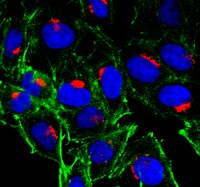MABF935 Sigma-AldrichAnti-MPR300/IGF-2R/CD222 Antibody, clone 2C2
Anti-MPR300/IGF-2R/CD222 Antibody, clone 2C2 is an antibody against MPR300/IGF-2R/CD222 for use in Immunocytochemistry, Immunohistochemistry, Affinity Binding Assay, Western Blotting.
More>> Anti-MPR300/IGF-2R/CD222 Antibody, clone 2C2 is an antibody against MPR300/IGF-2R/CD222 for use in Immunocytochemistry, Immunohistochemistry, Affinity Binding Assay, Western Blotting. Less<<Productos recomendados
Descripción
| Replacement Information |
|---|
Tabla espec. clave
| Species Reactivity | Key Applications | Host | Format | Antibody Type |
|---|---|---|---|---|
| H | ICC, IHC, ABA, WB | M | Purified | Monoclonal Antibody |
| References |
|---|
| Product Information | |
|---|---|
| Format | Purified |
| Presentation | Purified mouse monoclonal IgG1κ antibody in PBS without preservatives. |
| Quality Level | MQ100 |
| Physicochemical Information |
|---|
| Dimensions |
|---|
| Materials Information |
|---|
| Toxicological Information |
|---|
| Safety Information according to GHS |
|---|
| Safety Information |
|---|
| Packaging Information | |
|---|---|
| Material Size | 100 μg |
| Transport Information |
|---|
| Supplemental Information |
|---|
| Specifications |
|---|
| Global Trade Item Number | |
|---|---|
| Número de referencia | GTIN |
| MABF935 | 04055977333329 |
Documentation
Anti-MPR300/IGF-2R/CD222 Antibody, clone 2C2 Ficha datos de seguridad (MSDS)
| Título |
|---|
Anti-MPR300/IGF-2R/CD222 Antibody, clone 2C2 Certificados de análisis
| Cargo | Número de lote |
|---|---|
| Anti-MPR300/IGF-2R/CD222, -Q2664151 | Q2664151 |
| Anti-MPR300/IGF-2R/CD222, clone 2C2 - 3548330 | 3548330 |
| Anti-MPR300/IGF-2R/CD222, clone 2C2 - 4045182 | 4045182 |







